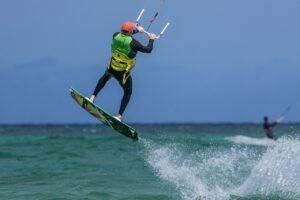I am sure that you would love to be on the kiteboard from the very beginning? But you know what: It is more important to learn how to maneuver the kite, and the best way to learn that is by doing it on land.
Why is it so important to first learn to control the kite? Well, if you don’t learn this, you will be held back by your ability to control the board when you ride the waters. So, have some patience and put in the effort to learn to fly the kite when you wear a harness at the beach.

Many students find the most difficult part of beginning instruction the temptation to skip steps. Lessons one and two will often focus on theory, mechanics, wind and weather conditions, and rigging, and how to move around with and without the board. Take to time so learn safety and kite control. This will make you a better kiter.
AFTER you got that initial groundwork, you can get to the water, learn to get up on the board, maneuver the kite on the board, and do some body-dragging. Again, do this basic groundwork and you will be more confident and develop your skills and ability to appreciate this wonderful water sport even more. Your first start on the water will be easier, you will have fewer crashes and more real riding time. Wow!
In addition to that, how else can you get the most out of your first lessons? To give yourself an edge from the very beginning, here are some areas that you can focus on prior to your lessons.
A trainer kite can make a huge impact on your kite awareness, so why not do some practice using a trainer kite? They can even be used for kiteboarding and are different from the inflatable tube kites that some use. They are easy to fly, and you can depower them completely in case you would do some mistakes when riding. They are also relatively inexpensive. To give you practice, some instructors and trainers will loan you a used trainer-kite. These trainer kites should mostly be used with handles and a bar. This helps to make them more similar to a kiteboarding kite.
Ask a friend who is a good kiteboarder to spend an hour with your to help you get started. Then you will be able to fly the kite by yourself.
Some kiteboarding schools offer helmets that have built-in radios! Nice detail, huh? This allows for easy communication between you, your instructor, and the rest of your environment.
If you really feel that you are serious about learning how to kiteboard you can take water lessons that include one-on-one instruction. These one-on-one water lessons can be physically demanding. Even if you are pretty darn athletic and really fit, we recommend booking water lessons on different time slots so that you get opportunities to rest in between.

If you feel really confident about learning this watersport, then you can book a one-day instructional session. This is specially earmarked fast learners, who often have been doing paragliding and similar athletic air- and water adventures. You can also join this class if you are a kiteboarder who feels that you need to get a stronger foundation before moving on to the intermediate classes.
This private one-on-one full-day surf lesson will definitely teach you how to fly a fully powered kite. Rest assured, you will learn how to relaunch your kite (if it has been dropped onto the water). We will also make sure that you will learn how to harness the amazing wind power to move and direct yourself in the direction you choose. This includes moving and zig-zagging upwind.
Have you now been working closely with your instructor for about two to three hours? Then you will be able to get on your board and start riding. Rest assured, in many cases you’ll be able to perform basic kiteboarding maneuvers in a matter of a few hours. It can be an amazing feeling!
Are you on your own from now on? Not really, the instructor will still be around. He, or she, will assist you and be that voice in the radio helmet. I know many students who have winded up several kilometers from their starting point. They had some sore muscles but many big smiles. Perhaps you will be one of them?


